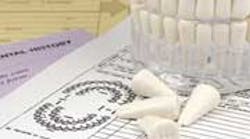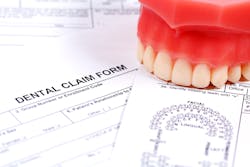The new CMS 1500 claim and how to avoid common stumbling blocks
Dental offices are being forced to submit claims to medical insurance more often. It seems like dental insurance carriers are requiring claims be submitted to medical carriers before the dental plans will even process the claims. I’ve heard from many offices that they’ve sent claims to medical carriers and received no response, or that the process takes forever.
As I’ve talked with staff members, I’ve learned that in many instances the claim forms are completed incorrectly, which is part of the reason the claims are not being processed. I know that carriers can sometimes be less than helpful in guiding offices through the process of completing a claim form. Let me share some of the more common errors I’ve seen with some of my clients. You and I both know that if we do a better job of completing the claim forms correctly, the better chance we’ll have for getting the claims processed.
I won’t go through every box of the claim form. You can find detailed instructions about how to complete the boxes at the National Uniform Claims Committee website at www.nucc.org. What I want to review here are some highlights of where I see people stumble.
Rule 1: Do NOT hand write your claim forms. I’m going to tell you what happens to handwritten claim forms. Not only do handwritten claim forms delay the processing, when we hand write something we’re relying on someone else to interpret our handwriting and input the information into their system. I think we can all agree that’s not the best choice for claims processing. If possible, send claims electronically. If you can't send something electronically, at least make sure the information is typed into the form.
Rule 2: Use the most current CMS 1500 form. This form is printed with red ink. The bottom right hand corner should state, “APPROVED OMB-0938-1197 Form 1500 (02-12).” Any other versions are obsolete and will not be accepted by insurance carriers. Although the form is printed in red ink, you do not have to complete the form in red ink. It should be completed in black ink.
ALSO BY TERRI BRADLEY:Dental coding ICD-10 CM – Time to prepare your practice now!
Within the claim form itself is where a lot people stumble. In the upper right hand corner, list the insurance company and address. If the address is a four-line address, complete it all. If it is a three-line address, leave a blank between lines two and four. For example:
ABC Insurance Company ABC Insurance Company
9999 Main Street 9999 Main Street
Suite 100
Everywhere, MA 55555 Everywhere, MA 55555
Box 1: Do not leave this box blank. If it’s a Medicare claim, check the Medicare box. If it’s a group health plan, check that box. Claims will be returned unprocessed by carriers if this field is not completed. You can visit the NUCC website on how to properly complete the demographic information for the patient and the insured.
Box 10: Each question must be answered with a yes or no; nothing can be left blank. If the patient’s condition is related to his or her employment, auto accident, or other accident, a yes box must be checked. Carriers require this box to be completed to alert them of the possibility of another insurance carrier or entity having primary responsibility for the payment of claims (i.e., workers comp or auto insurance). If you check the yes box that the services are related to a patient’s employment, the carrier will consider worker’s comp to be responsible for the claim. If it is not, check “no” and the carrier will proceed with processing the claim.
Box 17: If another health-care provider referred the patient to you, list the name and credentials of the referral in Box 17. In addition to the name of the referral, you must also list the qualifier to identify which provider is being reported — DN for a referring provider, DK for an ordering provider, and KQ for a supervising provider. When listing the name of the referring provider, do not use any punctuation in the name. (John Smith MD, not John Smith, M.D.) Also, if you complete Box 17, Box 17B is a must. Carriers require the NPI number of the referring provider you list in Box 17. To obtain this information, you can either call the referring doctor’s office or search the NPI registry online at https://npiregistry.cms.hhs.gov/NPPESRegistry/NPIRegistryHome.do.
Box 19: This is one of my favorite fields on the claim form. This is a free text box that allows you to submit additional information to the carrier without having to send in extra paper. Use this field to provide narratives or further explanation of the codes. For example, we know there is no specific CPT code for many dental procedures. Although according to HIPAA guidelines medical insurance carriers are supposed to accept the D codes on medical claim forms, we’ve found that some carriers prefer you use a CPT code. CPT 41899 – unlisted procedure dentoalveolar structures – is a common code to report.
When you report that code to a carrier without additional information, the carrier has no idea what you actually did. You could be reporting a restoration, an abutment, a crown, an extraction, or something else. Rather than sending a separate narrative to the carrier explaining the service you performed when you submit CPT 41899, you can report this information in Box 19. If you’re reporting an extraction to a carrier in Box 19, you could write 41899=D7140, tooth No. 18. You have sufficiently reported to the carrier that you extracted tooth No. 18 without having to send additional paperwork. You can also use this field to let the carrier know you’re sending in a corrected claim.
Box 21: This field is a must for all medical claims and cannot be left blank. This is where you report the ICD-9 CM codes. The carrier does not want any words in here; use codes only. The primary code that best supports the reason for the procedure is recorded on the first line (A) and any secondary codes are reported on the second line (B).
Box 24: This is where you report the procedures or services you provided to the patient. Not all boxes in this section have to be completed.
Box 24A: This must be completed with the date of service to and from.
Box 24B: This must be completed with the appropriate code regarding where the service took place, (i.e., 11 is used to report services rendered in a provider’s office).
Box 24C: EMG or emergency can be left blank unless required by the carrier or state or federal guidelines, not by your office internal guidelines. According to NUCC guidelines, this box should only be completed with a Y for yes if it falls under “The definition of emergency would be either defined by federal or state regulations or programs, payer contracts…” not the office’s definition of emergency.
Box 24D: Procedure CPT or HCPCS code is listed in the white spaces on the form. In the shaded area of Box 24 right above the line where you enter the procedure code is another place to give more information to a carrier or submit a narrative. This section should be completed using the NUCC guidelines and modifiers. Use the NUCC method of reporting information in Box 24. When reporting a narrative, place the ZZ modifier prior to the narrative. This alerts the carrier that the information in this field is a narrative. For example, using the same extraction example, the shaded area in Box 24 would be ZZ D7140. To report tooth numbers, use the JP modifier. For example, JP 18 lets the carrier know this is related to tooth No. 18. To report multiple tooth numbers, list the teeth with no punctuation, i.e., JP 22 18 12 5. To report a narrative and teeth together, type ZZ D7140 JP 18.
Box 24E: This is the diagnosis pointer. This could be one of the most important boxes on the entire claim form. This is where you support the medical necessity for the services you’re submitting. Proper linking of the diagnosis code in Box 21 to the procedure code listed in Box 24 can determine whether or not your claim will be paid. Do not leave this field blank or your claim will be denied. If you only list one diagnosis code, the letter A will go here to link the diagnosis from Box 21 to the procedure listed on this line. If there are different diagnosis codes for each procedure, make sure they’re properly linked. If you’re linking multiple ICD9-CM codes to a procedure code, list the corresponding letters, not the codes that best support the medical necessity.
Box 24F: Enter your fee without dollar signs or punctuation.
Box 24G: This is the number of units to be reported. In many cases this number is one, however, there are times that you may report multiple units on the same line. If you removed multiple teeth, you could list the procedure code D7140 once and place the number of units or teeth removed in Box 24G. Make sure if you’re listing multiple units that your fee reflects the total charges. For example, if you typically charge $100 for an extraction, list D7140 one time, put $300 under charges, and put three in units. This lets the carrier know you removed three teeth for a total charge of $300.
Box 24J: This field is required and must have the NPI of the doctor who provided the service (individual number, not the practice number).
Box 27: This is where you accept assignment – yes or no. Check with each carrier to receive clarification on what each of these choices mean to that specific carrier. Some consider a yes to mean that the fee schedule will be accepted in full with no balance billed to the patient, while others consider a yes to mean that the check will go to the provider. Other carriers consider a no to mean that the correspondence will go to the patient and not the provider. I recommend checking with the carriers to avoid any surprises about payment.
Box 29: This box is for the amount paid and should be left blank unless the claim is a coordination of benefits. The amount paid by the patient should not be entered into the box. Many carriers do not require this to be completed unless it is a COB.
Box 32: List the name and address of the place where the services were performed.
Box 33: Enter the billing office, the name and address of the billing provider, and the NPI of the practice, not the individual (if there is a separate one).
If your software can print medical forms, I recommend that you do so. Some software programs will complete the CMS 1500 forms as a PDF if your software is unable to print the medical forms.
This is not meant to be a complete step-by-step guideline for the CMS 1500 form, simply an article about some of the common mistakes that I encounter. The NUCC website is a great resource for an in-depth explanation of the CMS 1500. Don’t forget to check with your carriers to see if they have any supplemental instructions for claim submission.
Happy coding and apply my mantra — “Keep calm and code on.”








